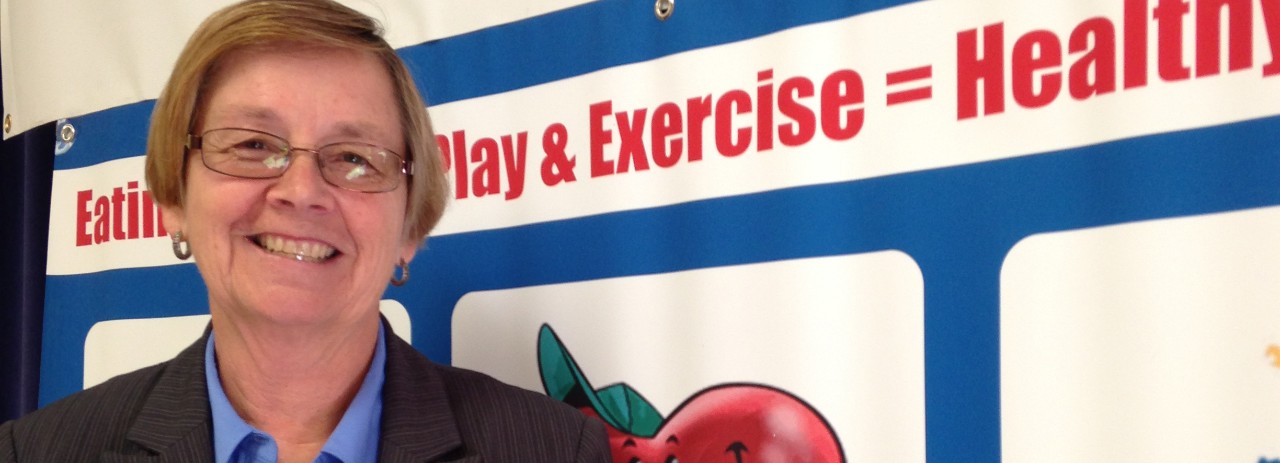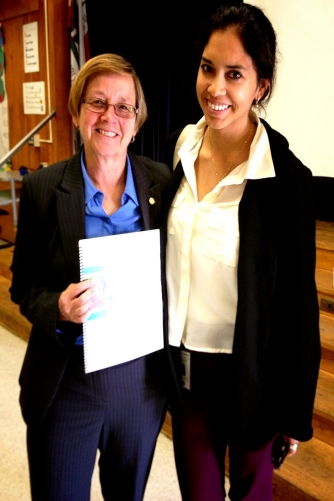
On November 18, 2013, Chula Vista Elementary School District (CVESD) launched their Body Mass Index (BMI) Surveillance Kit. The kit is a user-friendly guide for school districts throughout San Diego County and nationwide who are committed to understanding how childhood obesity, poor nutrition and lack of physical activity may be impacting the children in their schools.
In 2010, CVESD embarked on a journey to measure the height and
weight of approximately 25,000 students in all 44 of their District
schools. They discovered that almost 40% of their students were at an
unhealthy weight. The District partnered with the Board of Education,
principals, staff, parents, community members and students to
communicate the results and revise the District’s
Wellness Policy. They strengthened food and activity
guidelines, improved nutrition services by reducing fats, sugars and
salts, and monitored results. When the District measured the BMI of
26,000 students again in 2012, they saw a 3.2% decrease in the number
of obese and overweight students.
The District was
encouraged by these initial results and is dedicated to continuous
improvements in healthy weight over the long term. CVESD’s goals for
the coming year are to communicate, implement and establish a plan to
monitor district-level and individual school wellness compliance.
Additionally, a four-year grant will support increasing the quality
and quantity of physical education and physical activity in 19 of
their schools.
The BMI Surveillance Kit includes a
description of this journey and customizable templates for other
districts to use in measuring and communicating their students’ BMI.
A project of this scope requires the support and collaboration of educators, County of San Diego officials and Health and Human Services Agency staff, community leaders, parents, and children. It also requires the tireless devotion of a champion who has dedicated her life’s work to improving children’s wellness.
We recently sat down for an interview with such a champion, CVESD’s
Wellness Resource Teacher, the esteemed Sharon Hillidge. A San Diego
County native, Sharon has served as an educator, mentor and advocate
for children’s wellness at CVESD for the past 35 years and counting.
Since the 8th grade, she knew what she wanted to do, and she has
followed her passion for teaching physical education and connecting
with kids throughout her career.
How did the BMI
Surveillance Project get started?
In the early 2000’s, I sat as a representative of CVESD
on a Healthy Eating, Active Communities (HEAC) planning committee.
Primary care, public health and city officials joined together to
start developing relationships, recognizing that we could collaborate
and really benefit from sharing resources. Collaboration was a whole
new idea. We met for five years and made many connections.
Then, in 2006, I began working on our district wellness team.
In 2007, I became the District Wellness Lead for the committee. I
quickly realized that we hadn’t communicated any kind of wellness
information to our staff or to our parents. We had developed policy
based on what the state said needed to be created, but we really
didn’t understand what was involved and who was needed to help create
that policy. Through the committee, we developed a wellness
brochure. It was exciting. We kept getting more input from our
school communities about challenges and needed changes, so we decided
to take on revising our entire Wellness Policy. At the same time we
realized that we needed data to support some of the things we were
already seeing in our state-mandated, fifth-grade physical fitness
courses: low fitness scores and high BMI numbers. For an elementary
school district, fifth grade is far too late to really be looking at
children’s wellness. So we started putting together a plan to
understand children’s health markers at a much earlier age.
What challenges did you face early on?
The idea of measuring BMI is pretty controversial. We
spent a lot of time helping people understand the difference between
screening and surveillance. Our plan wasn’t the same as sending
individual information home from physical fitness tests to parents. We
were more interested in looking at the collective - what did our
kindergarteners look like? What did our first graders look like? Were
they already at an unhealthy weight?
And then there was
the matter of organizing. Once the District made the decision to do
it, we were looking at measuring 44 schools in six weeks, leaving only
a two-day window for each school. The principals were so gracious in
making it work. And the timing was right. The principals could see
the potential benefit the project could have on their school sites.
They heard the complaints coming in from teachers and parents about
the quality of food, the pizza and birthday parties - there was so
much food in the school environment beyond the school lunches.
Once the data started coming in, how did principals and
parents respond?
We worked with Leslie Ray in the County’s Community
Health Statistics unit to communicate the data in a way that
would be easy for people to understand. She created a pie chart and a
table by grade level, and we presented to the District Advisory
Committee, made up of parents and administrators - 125 people. What I
will remember most from our presentation is the audible reaction heard
in the room when Leslie showed parents where their kids were on the
growth chart – the intake of air. They were shocked. She went on to
say that Chula Vista was brave for actually doing the measurements and
if we were to look at other districts, we would probably find the same
things. We had chartered uncharted territory.
Our focus
has really been to communicate what we’re doing, and to actively
engage with students, their parents and the community. We’re
literally working in the schools. Parents are starting to ask us what
they can and cannot sell for fundraisers – if cookies and treats are
okay and compliant with the Wellness Policy. The School Board is just
as invested in wellness as our wellness committee, supporting many
controversial policy revisions. For example, everyone thought there
would be major pushback about removing flavored milk from the menu,
because it happened in other cities, but we had none. We have the
data that supports why we’re not adding more sugar to the menu.
What’s the best part about what you do?
It’s teaching. That’s what I knew I wanted to do. I
knew I wanted to teach physical education, but I would not have
imagined that this is where the road would end up taking me. The best
part for me as a teacher, as an educator, is that it’s always been an
adventure. I’ve always been in positions with enough change to keep me
growing and learning. I had to learn all about wellness before I
could go out and teach this to other people. And then I had to start
practicing it. I had gotten into the habit that a lot of adults get
into, by letting work take over, by not getting enough physical
activity or eating right. So this last year for me has been about
getting healthier, about focusing on my health. I have lost 60
pounds.
What are you most proud of?
When I retire in a few years, this project will be my
legacy. It all comes full circle. It began with me thinking I could
make a change and with my passion for physical activity and the ideas
of success on the playground. I’m a proponent that there are a lot of
life lessons you can learn on the playground like cooperation,
teamwork and personal responsibility, to name a few.
My
wish is that districts/schools will promote better balance between the
academics and the health and wellness of our youngsters so we can
envision a future where they have the skills, knowledge, habits and
behaviors to carry them forward into adulthood. Learning good habits
now makes it so much easier as you go into adulthood, because that’s
what you fall back on - the things you learned early on. I teach kids
how to read nutrition labels. Some parents have jokingly complained
that they can’t go to the grocery store with their kids, because their
kids take everything off the shelves and say, “No, no, this has so
many calories.” It’s the best thing I can hear - the most rewarding
thing that I can hear - that parents are learning something from their
children. And then the parents say, “Okay, I can do better. We can do
better.”
We somehow fell into “fast, easy and convenient”
in our generation. We have to go back now to slowing it down,
creating environments where we have family dinners around the table
and enjoy conversation. There are things we used to do in the “old
days” that we need to recycle: having a healthy family dinner,
teaching people how to cook, making healthy food more accessible,
planting gardens, children playing in their neighborhoods, and more
family-centered activities.
What have you learned from
the kids you work with?
They listen to us. Sometimes we get so engrossed in
fighting the good fight that we lose sight of the people whom we are
hoping will get the message. But when I’m teaching, teaching an idea
about food or health, and the kids get it, that’s when I get most
excited. Because if they get it, it’s something that they will
remember, and they become advocates. To have a fifth grader ask you,
on a food label, “Why are they lying to us?,” for him to be wise
enough to figure out that they are using advertising to tell us that
it’s healthy and then to read the label and find out it’s not. That’s
an advocate, a future advocate. It’s the beginning of a seed that
they can be our champions for better health.
Kids are
the problem solvers of our future. They will be making the decisions
at some time. We need to keep asking ourselves, “What information are
we giving them that is going to carry them forward?"
Any final words of wisdom?
One of the things I learned a long time ago is that it’s
not about telling people, it’s about showing them. I’m a proponent of
walk the talk. People are often saying, “Oh, I’d do that if I had
this.” You give people information and resources to eliminate excuses.
Knowledge is power. Then it’s up to them to make their own
decisions. None of us like being told what to do.
I’m
hoping that this BMI Surveillance Kit is one such tool that helps
districts/schools develop better wellness programs and policies. If
one of the largest elementary school districts in California could do
it, so can anyone else. Our goal is to provide tools to move forward.
It’s all about information and collaboration – working together to
give children the knowledge and tools to be advocates for healthy living.
Photo: Sharon Hillidge (left) with the lead designer of the BMI Surveillance Kit, Brooke Lejeune-Chanman, Health Information Specialist at the County of San Diego
